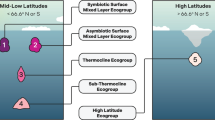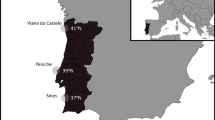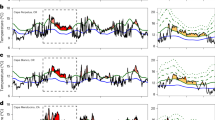Abstract
There were highly significant changes in the structure of benthic infaunal communities at the end of the last cold regime (1976) compared to the end of the last warm regime (1999) in the California Current. The warm regime is characterized by much lower plankton production, which we argue is the primary cause of the degraded infaunal community at the end of the warm regime. In 1997-98, we resampled a depth gradient along a subtidal, high-energy sandy beach (6-24m) in Monterey Bay that was sampled for five years at the end of the last cold regime (1971-75). There was a dramatic decline in the total number species, number of individuals, and biomass by the end of the warm period. There was no overlap in benthic assemblages at all water depths between the decades in either non-metric multidimensional scaling ordination or cluster analysis. In the 1970s, the community dominants in the shallow crustacean zone, centered in 9 m, were pericarid crustaceans, including predacious phoxocephilid amphipods, haustoriid amphipods, and ostracods, which all live in the sediment. The amphipods, in particular, are well adapted to burrowing in sand. The numerical dominants in the deeper polychaete zone (18-24m) were large, sedentary polychaete worms. The largest was a tube-dwelling predator (Nothria) accounting for most of the biomass. The other was a suspension and surface deposit feeding polychaete worm, Magelona. By the 1990s, the most abundant crustacean was a small, swimming amphipod; and the most abundant polychaetes were small, relatively mobile, and deposit feeding. This trend from large size, sedentary, and suspension feeding to smaller size, higher mobility, and deposit feeding also characterizes infaunal shifts from the food-rich continental shelf into the food-poor deep sea. The dominant polychaetes had more opportunistic life histories, and shallow faunal zones extended into deeper water in the 1990s. If global warming continues, the ongoing cold regime may be less productive and the sandy bottom communities should not develop the species composition and high diversity, abundance, and biomass observed in the 1970s.
Similar content being viewed by others
Article PDF
Author information
Authors and Affiliations
Corresponding author
Rights and permissions
About this article
Cite this article
Oliver, J., Kim, S., Slattery, P. et al. Sandy bottom communities at the end of a cold (1971-1975) and warm (1997-1998) regime in the California Current: impacts of high and low plankton production. Nat Prec (2008). https://doi.org/10.1038/npre.2008.2103.1
Received:
Accepted:
Published:
DOI: https://doi.org/10.1038/npre.2008.2103.1



